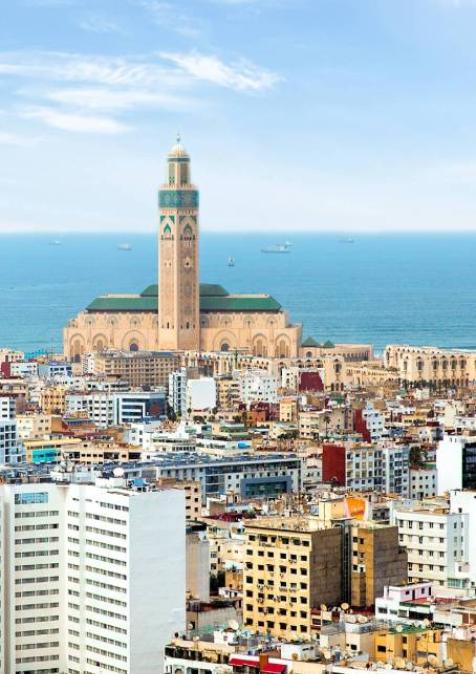Publications /
Opinion
“Out of the Eurocentric box”
This young planner and lecturer at the Departement of International Urbanism of the University of Stuttgart (Germany) spontaneously describes himself as a “Marrakchi, ambitious and curious” person. His birthplace and family’s influence matter a lot in his professional journey. Not only because the Red City is “an inspiring place for its history, architecture and culture”, but also because his grandfather was a well-established tile maker, who participated in the edification of many historical palaces in Marrakech
“I was just lucky enough to be able to listen to myself when I had to make a decision”, he recalls. His choice was to study at the only public architectural school in Rabat, l’Ecole nationale d’architecture (ENA). Getting admitted there was like “winning the jackpot”, he remembers, since only 60 students are selected each year among 3,000 applications. “It was the right place, and it turned out to be great”.
On his fourth year of a six years cursus, he got a DAAD scholarship for an exchange program at the University of Technology in Berlin, where he started what was going to be his new life in Germany. There, he took part in the large research project “Future Megacities – Energy- and Climate-Efficient Structures in Urban Growth Centres”, funded by the German Ministry of Education and Research. The project aimed at developing sustainable urban strategies in nine cities around the world, mainly located in the global South, each having a specific topic, such as water in Lima, mobility in Shanghai or urban agriculture in Casablanca.
Megacities of the Global South
He focused on Casablanca, “a vibrant and dense city of 4 million inhabitants with scarce green spaces, where urban agriculture could be introduced as a productive green infrastructure, offering a new nexus between energy, food security, and sustainable urban development”.
Vacant plots had to be spotted, among which some 20 hectares along train tracks. A discussion was engaged with the authorities and several pilot projects were implemented. The sustainable management of the scarce water resources was at the center of these projects. One of the solutions was to introduce on-site water treatment plants in informal settlements to recycle the used water of Hammams (public baths) for urban farming and the irrigation of green spaces.
After a year in Berlin, he spent 2012 in Shanghai, a megalopolis of 25 million dwellers, where everything takes place at another scale. “I was very excited to go to China, a vibrant place, transforming very fast, with very bold ideas and daring experiments in architecture and urbanism you might not find anywhere else in the world”. There, he learned the “do’s and don’t” of the Chinese model.
Back in Berlin, he became a staff member of the project on megacities, as a coordinator until 2014. He worked on the implementation phase, testing new ideas, such as developing organic food production in a small field in Casablanca, with a corporation of 25 farmers who were trained. “We organized the food baskets to connect the farmers to the inhabitants and markets, which led to a 200% to 300% increase of the farmers’ income”.
Out of the Eurocentric Box
He remembers the Atlantic Dialogues Emerging Leaders program fondly, being selected in 2015 to what he describes as one of the “less Eurocentric” leadership programmes he has ever attended. “It brings you tremendous energy, space for inspiration, networking and learning. You meet all these brilliant minds and energetic people from the Global South, from all sectors, who take you out of your bubble”. The ADEL program was short in his view, “but the network was way stronger afterwards”.
Among his favorite readings, he mentions Sapiens, by Yuval Noah Harari, “a brief history of human kind with interesting perspectives, on digitalization and how human beings are using their transformative power to change nature”. He reflects on the impact of digitalization on urbanity, a big topic under the Covid-19 pandemic. The latter has uncovered huge spatial inequalities in cities, and calls for the rethinking of urbanity, public space, and above all encourages us to establish a more inclusive and environment-friendly urban model.
Besides these new lines of reflection, his dream is “to be able to make a difference in terms of highlighting or recontextualizing urban planning in the Global South, putting the spotlight on culture of planning. City planning has unfortunately been a strong vehicle to impose a Eurocentric model and a one-sided understanding of modernity. However, there is a lot that can be learnt from the flexibility and the resilience of cities in the Global South, and the way they cope with urban issues”.
Dubai, in his view, is the perfect example of how one should deconstruct the impact of the Eurocentric perspective on how a “modern city should look like”. “This view is rooted in New York, Tokyo, Singapour, but we have to redefine what sustainable progress is… It’s a bit superficial to think about the tallest skyscraper or the most transparent facade as sign of progress. The city is a space where culture matters, and I’m not sure that with replicating Dubai in Ghana, for instance, you don’t widen this gap between who we are and the kind of image that is forced on us. Every place has its context, its history and has to develop its own image and imagination. That model is not universal.” Sabine Cessou
You can consult Yassine’s portrait along with others on the ADEL Alumni Portrait page.




